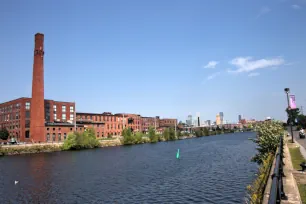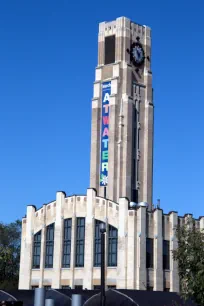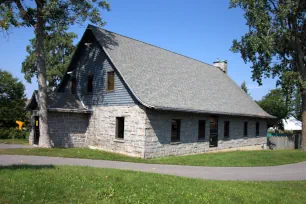The Lachine Canal was built in 1825 to bypass the Lachine rapids on the St. Lawrence River, which posed a serious obstacle to those traveling upriver. The canal, which links the old port of Montreal with the borough of Lachine, is now used only for recreational purposes.
Creation of the Canal


Between Lake Saint Louis and the port of Montreal, the Lawrence River drops significantly, and the resulting rapids created a serious obstacle for shipping goods between eastern and western Canada. As early as in 1680 proposals were made for the construction of a canal that would bypass the rapids. It would allow boats to ship goods straight from the Great Lakes to Montreal.
Work on the canal finally started in 1821 and four years of digging later the canal was completed. The canal had seven locks to overcome a difference in elevation of fourteen meters (49 ft.). The creation of the canal resulted in a boom of industrial activity in the area. The canal was widened twice in the nineteenth century. However, the emergence of rival transportation methods and the opening of the Saint Lawrence Seaway in 1959 made the Lachine Canal redundant and in 1970 it was closed to shipping.

Sights along the Canal
The canal is now used for recreational purposes only and people use the pathways along the canal for walking and biking, away from any car traffic. The scenery around the canal is beautiful and varies from remnants of industrial activity to serene nature.
Atwater Market
The most eye-catching landmark on the canal is the clock tower of the Atwater Market, a covered public market that opened in 1933. The Art Deco building was designed by the Québécois architect Ludger Lemieux. The market is home to specialty stores and stalls that offer a wide assortment of fresh produce from local farms.
Lachine Museum


At the Lachine end of the canal, where it joins the St. Louis Lake, near the Lachine lock and Lachine Canal Visitor Centre, stands an old stone house. This house, known as the Maison Le Ber-Le Moyne, was built in the late seventeenth century by two merchants. Since 1948 it has been home to the Musée de Lachine (Lachine Museum), which displays furniture and tools from the seventeenth century to the present day. The museum also organizes temporary art exhibitions of contemporary Canadian art. It also doubles as an archeological site and outside you find its open air museum with more than fifty modern sculptures spread out over three sites on and near the banks of Lake St. Louis.
Fur Trade Warehouse
Until the creation of the Lachine canal, trappers coming from the west traded their fur in Lachine. The Fur Trade in Lachine National Historic Site is a remnant of these days. The stone warehouse was built in 1803 to store trade goods, including furs. At the time, the large majority of the furs exported to Europe passed through Lachine. The building is now owned by Parks Canada, which uses it as a museum that tells the story of fur trade in Canada, once a major pillar of the country’s economy.
Bike Path
Montreal is North America’s most bike friendly city, and there are few better places to experience this than at the Lachine Canal. The bike path follows the canal for about fifteen kilometers (nine miles) and runs between the Old Port and the St. Louis Lake in Lachine. Along the way, you’ll hardly encounter any car traffic. Bikes can be rented at the Old Port or across the canal from the Atwater Market building.
- Next: Biosphere
- More Sights & Attractions in Montreal

